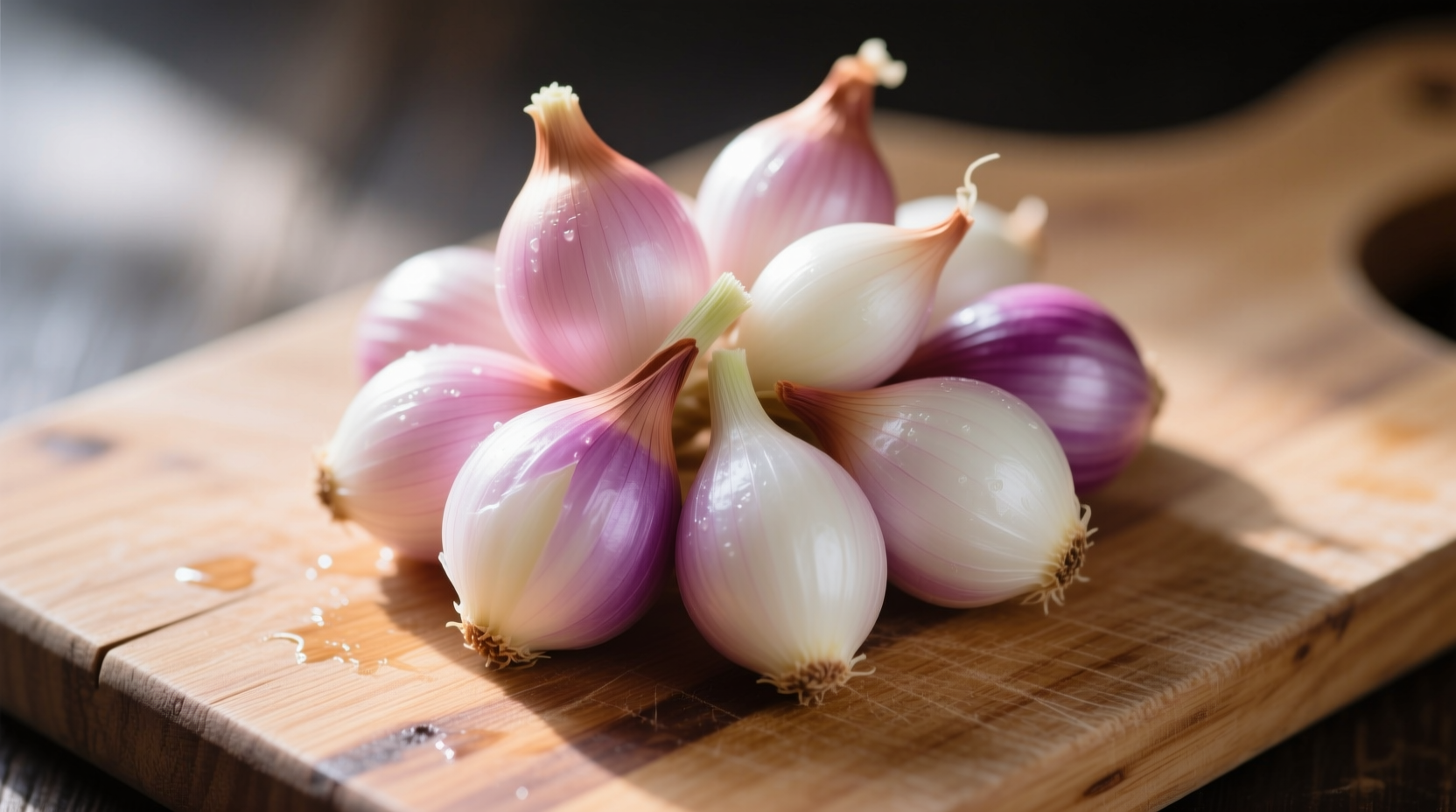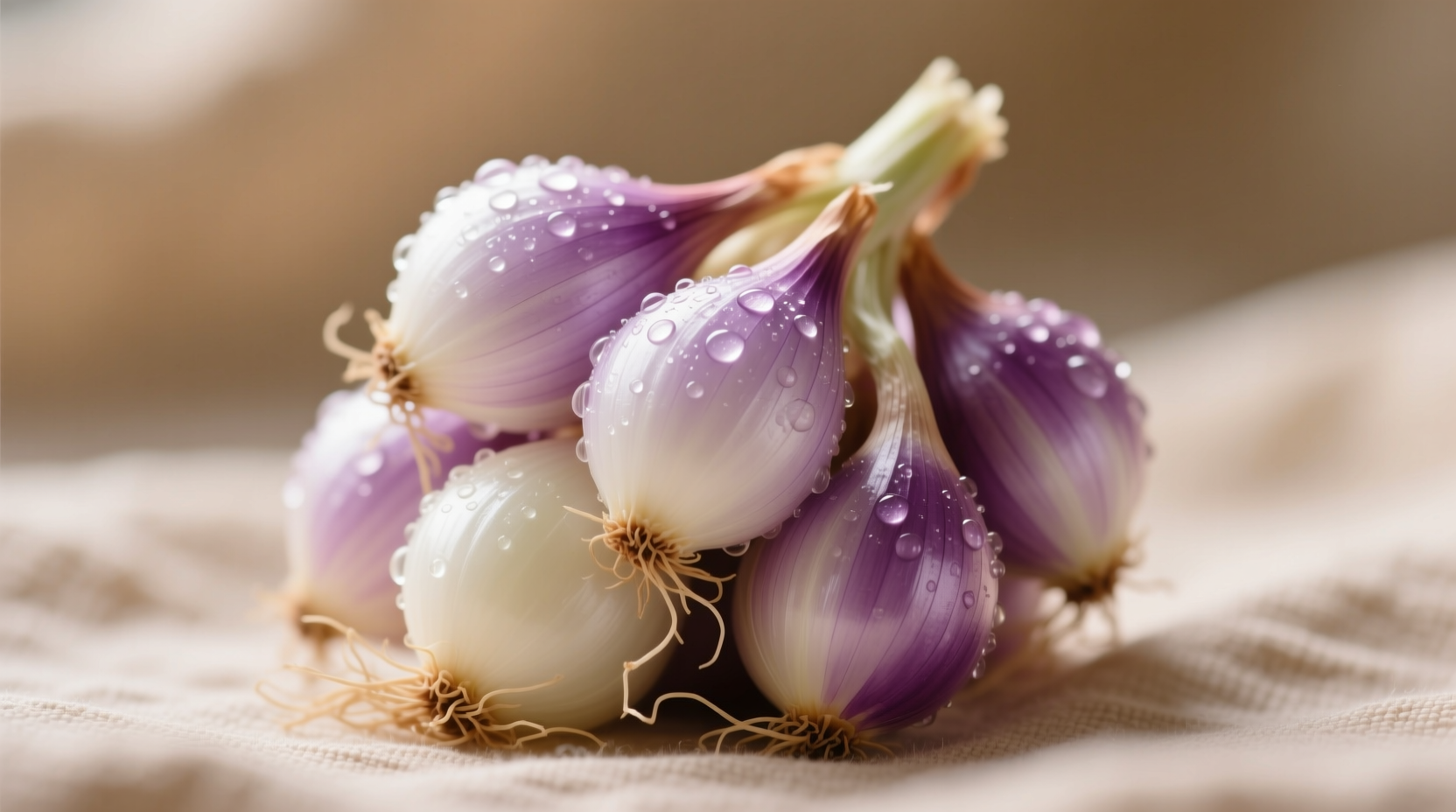When you reach for shallots instead of regular onions, you're choosing a culinary secret weapon that transforms ordinary dishes into restaurant-quality creations. These elegant alliums deliver nuanced flavor that regular onions can't match—especially in raw preparations where their mild, sweet profile shines without the harsh bite of standard onions. Understanding how to select, use, and substitute shallots properly separates amateur cooks from those who consistently create balanced, professional-tasting dishes.
What Exactly Is a Shallot Onion?
Shallots (Allium cepa var. aggregatum) belong to the same botanical family as onions, garlic, and leeks but form in clusters rather than single bulbs. Unlike the spherical shape of common yellow onions, shallots grow in elongated, tapered bulbs that typically cluster together under a thin, papery skin ranging from coppery brown to reddish purple.
Originating in Central or Southeast Asia, shallots have been cultivated for over 5,000 years and were highly prized in ancient Egyptian and Greek civilizations. The USDA Agricultural Research Service identifies shallots as having higher concentrations of certain flavor compounds like allyl propyl disulfide compared to common onions, which explains their distinctive sweet-yet-sharp profile that mellows beautifully when cooked.

Shallot vs. Onion: Critical Flavor and Culinary Differences
Understanding the chemical and structural differences between shallots and regular onions explains why professional chefs reach for shallots in specific applications. While both contain sulfur compounds that create that characteristic allium flavor, shallots have a more balanced ratio of these compounds resulting in less pungency and more complexity.
| Characteristic | Shallot Onion | Yellow Onion |
|---|---|---|
| Flavor Profile | Sweet with subtle garlic notes, mild heat | Sharp, pungent, more intense sulfur notes |
| Raw Application | Ideal for vinaigrettes, salsas, garnishes | Can overwhelm delicate dishes |
| Cooked Application | Mellows to rich, complex sweetness | Becomes sweet but retains sharper notes |
| Substitution Ratio | 1 medium shallot = 1/2 cup chopped onion | 1 cup chopped onion = 2 medium shallots |
| Storage Life | 1-2 months in cool, dry place | 1-3 months depending on variety |
When to Choose Shallots for Maximum Flavor Impact
Chef Antonio Rodriguez explains: "Shallots excel in applications where you want onion flavor without dominating the dish. Their higher fructose content creates a more complex caramelization than regular onions, making them ideal for pan sauces, reductions, and delicate braises." Professional kitchens consistently use shallots for:
- Vinaigrettes and cold sauces - Raw shallots provide flavor without the harsh bite of raw onions
- Fine dining reductions - Their nuanced flavor concentrates beautifully in demi-glaces and wine reductions
- Garnishes - Thinly sliced shallots add visual appeal and subtle flavor to finished dishes
- Asian cuisine - Essential in many Thai, Vietnamese, and French-Asian fusion dishes
For home cooks, the most transformative switch is using shallots in your next salad dressing. The difference between a dressing made with raw yellow onion versus raw shallot is immediately noticeable—shallots provide aromatic complexity without the eye-watering sharpness.
Proper Selection and Storage Techniques
Choosing quality shallots and storing them properly extends their shelf life and preserves flavor. When selecting shallots at your market:
- Look for firm bulbs with dry, intact skin—avoid any with soft spots or green sprouts
- Smaller shallots (about 1 inch in diameter) typically have the most concentrated flavor
- Firmness indicates freshness—give them a gentle squeeze to check
- Avoid refrigeration, which causes premature sprouting and texture changes
According to research from University of Minnesota Extension, properly stored shallots maintain peak quality for 30-60 days in a cool (50-60°F), dark, well-ventilated space. Never store shallots near potatoes, which emit ethylene gas that accelerates spoilage. Once peeled, store unused portions in an airtight container in the refrigerator for up to 14 days.
Shallot Substitution Guide for Emergency Situations
When you're mid-recipe and realize you're out of shallots, these substitutions work with important caveats:
- Yellow onion + pinch of sugar - Use 50% less onion than shallot quantity called for
- Red onion (for raw applications) - Soak in cold water for 10 minutes to reduce sharpness
- Scallion whites - Best for garnishes but lacks depth for cooked applications
- Chives - Only for finishing dishes; no substitute for cooking applications
Remember that no substitution perfectly replicates shallots' unique flavor profile. The Cooking Light Test Kitchen recommends keeping frozen minced shallots on hand for quick access to authentic flavor without the prep work.
Nutritional Comparison: Health Benefits Beyond Flavor
While both shallots and onions offer health benefits, shallots contain higher concentrations of certain beneficial compounds. Per 100g serving (USDA National Nutrient Database):
- Shallots contain 30% more allicin precursors than yellow onions
- Higher levels of quercetin, a flavonoid with antioxidant properties
- More potassium and magnesium per serving than common onions
- Lower glycemic index (25 vs 32 for yellow onions)
These compounds contribute to shallots' potential health benefits including improved cardiovascular health and anti-inflammatory effects. The unique sulfur compounds in shallots also support healthy digestion when consumed in moderate culinary amounts.
Professional Chef Techniques for Perfect Shallot Preparation
Mastering these professional techniques ensures you get the most flavor from your shallots:
- Peeling hack - Cut off both ends, score the root end, then drop in boiling water for 30 seconds before peeling
- Uniform slicing - Cut in half root-to-tip before slicing for even cooking
- Sweating technique - Cook over medium-low heat with butter until translucent (8-10 minutes)
- Raw preparation - Soak sliced shallots in ice water for 15 minutes to remove any residual sharpness
For vinaigrettes, finely mince shallots and let them macerate in the vinegar component for at least 15 minutes before adding oil—this extracts maximum flavor while mellowing any harsh notes. When making sauces, always sweat shallots before adding liquids to build a more complex flavor foundation.
Frequently Asked Questions
Can I substitute red onion for shallots in recipes?
Yes, but with modifications. Use 25-30% less red onion than shallots called for, and soak the chopped onion in cold water for 10 minutes to reduce sharpness. Red onion works best in raw applications like salads and salsas but lacks the subtle garlic notes of shallots in cooked dishes.
Why do my shallots sprout quickly after purchase?
Shallots sprout prematurely when stored in warm, humid conditions or near ethylene-producing fruits like apples and bananas. Store them in a cool (50-60°F), dark, well-ventilated space away from potatoes and fruits. Properly stored shallots should remain sprout-free for 4-8 weeks.
How much onion equals one shallot in recipes?
One medium shallot (about 1.5 inches long) equals approximately 1/2 cup finely chopped yellow onion. For precise substitution, use a 3:1 ratio by weight—3 parts onion for 1 part shallot. Remember that flavor intensity differs, so you may need to adjust quantities based on your taste preferences.
Are French shallots different from regular shallots?
Yes. True French gray shallots (also called griselle or Jersey shallots) have a more elongated shape, coppery-gray skin, and superior flavor complexity compared to the more common Dutch-type shallots found in most supermarkets. French shallots contain higher sugar content and lower water content, resulting in more concentrated flavor that's prized by professional chefs.











 浙公网安备
33010002000092号
浙公网安备
33010002000092号 浙B2-20120091-4
浙B2-20120091-4